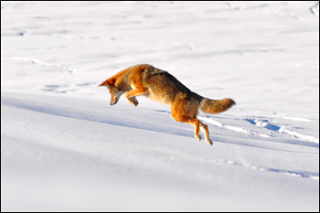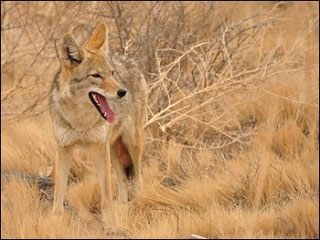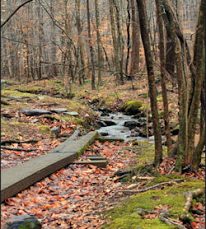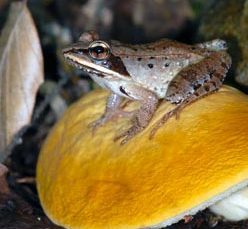

Coyote pounce. Credit flickr.com/JustinJensen
YES, there are coyotes (Canis latrans) living in the Great Swamp National Wildlife Refuge! Members of the Refuge staff have seen and heard them a number of times. And, you know if they live in the Refuge, you can be sure that they live throughout the rest of the Great Swamp Watershed region too.
At first glance, the coyote resembles a small German shepherd dog, yet its color can vary from animal to animal. Shades include black, brown, gray, yellow, rust, and tan. They have shorter, bushier tales than their dog cousins that they carry low — almost dragging on the ground. Coyotes also have longer, narrower muzzles than dogs.
Most of us have a very negative image of this spectacular animal. In popular culture, coyotes are portrayed as villains, dastardly outlaws, thieves, and all-around scoundrels. Just think about the impression you have of Wile E. Coyote — you know, the creature that remains in constant pursuit of the Road Runner in Warner Brothers “Looney Tunes” and “Merrie Melodies” cartoon. The long rap sheet of offenses we humans have pinned on the coyote could not be farther from the truth of their real lives.
Meet the Real Coyote


Canis latrans. Credit: flickr.com/~Shanth
Coyotes remain one of the world’s most successful mammals. They have been shot at, poisoned, trapped, and otherwise besieged over generations. Still, their cunning and intelligence have allowed them to thrive. Coyote behavior often defies generalization, so here are a few intriguing things to carefully consider about these “adaptable predators.”
Although they are descended from wolves, coyotes demonstrate some unwolflike behavior. They do not form highly structured packs, but prefer to live in loose confederations that vary with habitat conditions and food supply. They also are less territorial. And, while members of both species mate for life, coyote couples may choose to live together or live separately depending upon prevailing conditions. This tendency toward social flexibility has earned the coyote a reputation for individuality that is uncommon in the animal kingdom.
The coyote’s flexibility also extends to its eating habits. These opportunistic predators are true omnivores, and are as content hunting rodents, lizards, or rabbits, as they are scavenging carrion, insects, or berries. As a result, they are just as capable of making a living in urban and suburban settings as they are in rural or wilderness areas. This habit for ranging far and wide in search of food is often what brings coyotes into contact with humans.
Some wildlife experts estimate that the coyote has quadrupled its range throughout North America in recent decades. And, many now speak of the animal’s “urbanization”, as more and more individuals are found hanging about office parks, housing sub-divisions, and shopping malls. In fact, a pair of coyotes was spotted in New York City’s Central Park in 1985. That is saying a lot when you consider the lengths to which people have gone to limit or eradicate an animal many consider a nuisance and threat to human health.
So what is the secret to the coyote’s success? Maybe it is the fact that you are more likely to hear a coyote than you are to see one. These are animals that are shy by nature, and prefer to avoid confrontations with people. Maybe it is the fact that coyotes reproduce more rapidly and in great numbers when under threat. Where hunting is prevalent, coyotes are known to mate more often and have larger litters of anywhere between six and twelve pups on average. Maybe it is the fact that coyotes are always on the move. They can easily wander 25 miles in 24 hours. Maybe it is the fact that the coyote’s natural predators — wolves and mountain lions — have been declining toward extinction. Or, perhaps we need to consider all of these factors together before we can attempt to construct a more accurate picture of the coyote we know today.
While many of us continue to regard coyotes as a threat to our lives and livelihoods, it is important to remember that we are the ones responsible for forcing more and more contact between our species. Human sprawl destroys more and more coyote habitat every day. And, our habits–particularly our methods of waste disposal — make us an easy and dependable source of food in once-wild areas where food has become scarce.
So, if we want less contact between ourselves and coyotes, what do we do? Do we continue the failed tradition of spending hundreds of millions of dollars on eradication programs? Or, do we follow the coyote’s example and use our own wariness and flexibility to master the art of peaceful coexistence?
If you are in favor of at least experimenting with the idea of adapting to the presence of coyotes, here are some tips and tricks you can use for maintaining a peaceful coexistence.
Some Ways To Coyote-Proof Your Environment
While coyotes are shy, they also are constantly on the lookout for food. Here are some ways to further avoid contact:
- Coyotes are attracted to food scraps in garbage. Dispose of trash in a metal can. Make sure the lid fits tightly. Secure the lid with a bungee cord or chain.
- Coyotes infrequently prey on domestic animals, such as cats and small dogs. However, they may be attracted to areas where there are free-roaming pets. To prevent potential conflicts, keep small pets indoors, especially in the hours between dusk and dawn. Also, if you must feed your pet outdoors, pick up food and water bowls (as well as leftovers and spilled food) as soon as your pet has finished eating.
- Do not put out feed or water for coyotes or other animals that are prey for coyotes (such as rabbits, deer, squirrels or chipmunks). It’s really just asking for trouble.
- Construct and position bird feeders so that coyotes and their prey (squirrels and rodents) cannot get to the feed.
- Walk your dog on a leash and accompany your pet outside, especially at night.
- If you must keep coyotes out of fenced land, make sure your solid wood fence is at least six feet high.
- If you must keep coyotes out of unfenced land, reduce the number of brush piles, areas of low-growing vegetation, or other possible shelter sites.
- Because coyotes like to eat fruit, keep fruit trees fenced, or pick up fruit that falls to the ground.
What Should I Do If I See A Coyote?
What should you do if you encounter a coyote and you want it to leave? Here are some tips:
- Don’t run from the animal, but be as big, mean, and loud as you possibly can be.
- Shout or yell at the animal.
- Make other loud noises by clapping your hands, blowing a whistle, knocking two boards together or by using a car horn, air horn, or other noise-making device.
- Wave your arms.
- If necessary, throw rocks and sticks at the animal.

